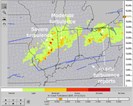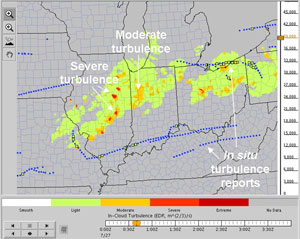NCAR Teams With United Airlines To Pinpoint Turbulence In Clouds

 Boulder, CO - A new turbulence detection system now being tested is alerting pilots to patches of rough air as they fly through clouds. The system, designed by the National Center for Atmospheric Research (NCAR) and tested by United Airlines on commercial flights, is designed to better protect passengers from injuries caused by turbulence while reducing flight delays and lowering aviation costs.
Boulder, CO - A new turbulence detection system now being tested is alerting pilots to patches of rough air as they fly through clouds. The system, designed by the National Center for Atmospheric Research (NCAR) and tested by United Airlines on commercial flights, is designed to better protect passengers from injuries caused by turbulence while reducing flight delays and lowering aviation costs.
The new system uses a mathematical method developed by NCAR scientists, known as the NEXRAD Turbulence Detection Algorithm, or NTDA, to analyze data obtained from the National Weather Service's network of Next-Generation (NEXRAD) Doppler radars. The resulting real-time snapshot of turbulence can be transmitted to pilots in the cockpit and made available to airline meteorologists and dispatchers via a Web-based display.
The research is funded by the Federal Aviation Administration (FAA) in partnership with the National Science Foundation, NCAR's primary sponsor.
"Pinpointing turbulence in clouds and thunderstorms is a major scientific challenge," says NCAR scientist John Williams. "Our goal is to use these radar measurements to create a three-dimensional mosaic showing turbulence across the country that can help pilots avoid hazardous areas, or at least give them enough warning to turn on the 'fasten seat belt' sign."
NCAR's NEXRAD turbulence detection algorithm (NTDA) generates real-time maps of in-cloud turbulence to alert airline meteorologists and dispatchers to potentially dangerous areas of rough air. The map above, generated by the system during early testing in 2005, shows areas of moderate and severe turbulence in the Midwest, as well as automated reports of turbulence detected by aircraft in flight (colored dots). In the cockpit, pilots receive a printout showing areas of turbulence along their flight path (below). (Images courtesy Research Applications Laboratory, NCAR).
The NTDA is being tested until October by a group of United Airlines pilots who fly routes east of the Rockies. The pilots, who receive information in their cockpits about turbulence detected ahead, report that the system provides them with accurate information about turbulence that is not available from any other source.
"The messages I've received in the cockpit gave a very accurate picture of turbulence location and intensity," says Captain Rocky Stone, chief technical pilot for United Airlines. "The depiction of turbulence intensity provides an unprecedented and extremely valuable new tool for pilot situational awareness."
Depending on the results of this year's tests, the next step may be to expand the system to additional United aircraft or other airlines. Williams anticipates that, by 2011, the NTDA will provide input to a system over the contiguous United States that will update comprehensive turbulence "nowcasts" for pilots and air traffic managers every 15 minutes.
"We hope this will provide a significant boost to the aviation industry in terms of passenger comfort, safety, and reduced costs," Williams says.
New data from existing radars
Pilots in the past have lacked accurate measurements of turbulence that develops in clouds and thunderstorms, partly because turbulent areas may be small, evolve quickly, and occur outside the most intense parts of the storm. As a result, FAA guidelines suggest that planes avoid thunderstorms by at least 20 miles when possible, even though large sections of that area may contain relatively calm air.
The NTDA captures turbulence in storms by peering into clouds to analyze the distribution of winds. It reprocesses radar data to remove factors that can contaminate measurements, such as sunlight, nearby storms, or even swarms of insects flying near the radar dish. It also averages a series of measurements to improve the reliability of its turbulence estimates.
This year's tests build on smaller-scale tests with United Airlines in the summers of 2005 and 2006 that showed it was possible to successfully detect moderate-or-greater turbulence more than 80 percent of the time. NCAR scientists have refined the NTDA since then, and expect that this year's demonstration will show additional improvements to the system's accuracy.
Impacts of turbulence
The NTDA does not measure clear-air turbulence, such as that caused by the jet stream or by wind flowing over mountainous terrain. But about two out of every three turbulence encounters are associated with clouds and storms, the focus of NTDA detection.
Turbulence has major impacts on aviation. According to a review of National Traffic Safety Board data from 1992 to 2001 by the National Aviation Safety Data Analysis Center, turbulence was a factor in at least 509 accidents in the United States, including 251 deaths (mostly in the general aviation sector). Additionally, the FAA Joint Safety Analysis Team estimated that there are more than 1,000 minor turbulence-related injuries on commercial aircraft annually. Airlines lose millions of dollars every year due to turbulence because of injury claims, delays, extra fuel costs, and aircraft damage.
SOURCE: National Center for Atmospheric Research
